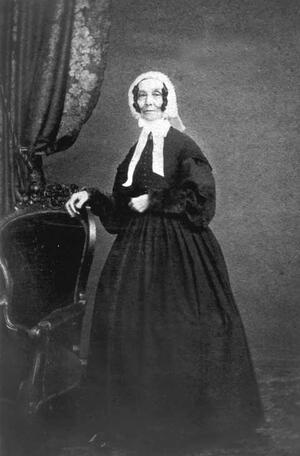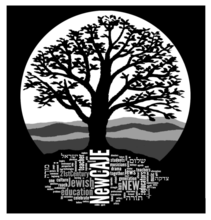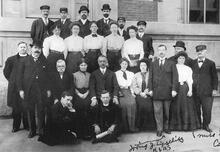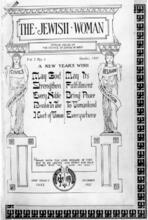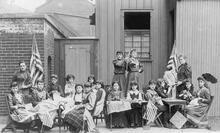Education of Jewish Girls in the United States
In early American history, most children received their education in private institutions; girls largely received their Jewish instruction from domestic life. The revolutionary development of the Jewish Sunday School movement, pioneered by Rebecca Gratz in the mid-nineteenth century, dramatically expanded access to Jewish education for girls as well as boys. The influx of East European Jewish immigrants in the late nineteenth century prompted the establishment of new Jewish educational institutions. Most of these children received their secular educations in public schools and their Jewish educations in supplementary programs, but Jewish day schools have also been an important educational re source for both girls and boys. In the contemporary era, the landscape for American Jewish education has expanded beyond the classroom to include a range of experiential educational opportunities.
Overview
Jewish girls growing up in the United States have had access to a broad range of educational opportunities. Pioneering innovations such as the Hebrew Sunday school opened up doors to religious education, while in public schools, training schools, and the hallways of higher education, American Jewish girls have pursued secular studies as well. In the contemporary era, the landscape for American Jewish education has increasingly expanded beyond the classroom to include a range of experiential educational opportunities alongside more formal classroom-based instruction.
Early History
The Jewish community in America planted its roots during the colonial era, and an educational infrastructure slowly began to germinate. Public schools did not become widely available in the United States until the mid-nineteenth century. Until then, parents looked to private institutions for the education of Jewish children, both in secular as well as in Jewish subjects. Day schools and boarding schools run by enterprising educators offered curricula that combined secular instruction with a curriculum for Jewish studies, typically focusing on basic Hebrew, biblical history and catechism. Some were co-educational, others were single-sex, like the Misses Palanches School in New York City, which offered a boarding school and a day school for Jewish girls. Congregational Hebrew schools also offered a full-day curriculum focusing on Jewish studies, usually taught by the community’s rabbi or cantor, but were typically limited to boys.
Most Jewish private schools prior to the twentieth century had only a short-lived existence. Enrollment was a perennial challenge, and schools were chronically short of funds. Wealthy parents often opted for private tutors who could teach the rudiments of general studies, alongside the heritage languages of Hebrew, German, Spanish, and Portuguese. Tutors also prepared boys for bar mitzvah, teaching mechanical Hebrew reading and Jewish liturgy for leading public prayers. In this period, girls did not celebrate Lit. "daughter of the commandment." A girl who has reached legal-religious maturity and is now obligated to fulfill the commandmentsbat mitzvah in the synagogue. They may have learned some Hebrew from private tutors, but more typically Jewish girls obtained their Jewish instruction from domestic life, learning the rhythms of the Jewish calendar, the organization of a Term used for ritually untainted food according to the laws of Kashrut (Jewish dietary laws).kosher kitchen, prayer-book Hebrew, and the performance of home-based Jewish rituals from their mothers, grandmothers, and aunts.
Sunday Schools
In 1838, a revolutionary new enterprise dramatically expanded access to Jewish education for children, girls as well as boys, whose families did not possess the means for private schools and tutors. On March 4, 1838, Rebecca Gratz opened the doors to the Philadelphia Hebrew Sunday School. Modelled on the Sunday schools operated by Christian churches, the Hebrew Sunday school offered its students a basic primer in Jewish topics that its teachers hoped would help Jewish children fend off the advances of predatory Christian missionaries on the streets of Philadelphia, as well as Christian influences in the city’s public schools. Meeting for just a few hours each Sunday morning, the children studied catechisms and bible stories in English. The school had little time for more intensive study, and its teachers, all female volunteers, had not received training in such subjects themselves.
The curriculum for Jewish learning offered by the Hebrew Sunday School was a dramatic departure from traditional modes of Jewish learning that foregrounded knowledge of Hebrew and familiarity with rabbinic literature. Yet it was a pragmatic innovation that recognized that American Jewish children were increasingly enrolling in the new public schools and had limited time for Jewish religious training. It also highlighted the equivalence of Jewish and Christian education—conducted on Sunday mornings, with a focus on theology and scripture, much of it shared by Jews and Christians. The Hebrew Sunday School Society of Philadelphia opened its doors to “any Israelite” and offered membership to any who could pay the sum of two dollars per year, or twenty dollars for life.
Gratz’s school was immediately replicated by other communities. Beginning in Charleston, New York, and Richmond, Sunday schools were founded across the country by enterprising women committed to volunteer work on behalf of their local communities. By the 1880s, Sunday schools had become the regnant model for Jewish education in America. In most communities, the Sunday school was integrated into synagogue congregations. It would become particularly prominent within the American Reform movement, which saw in Gratz’s curriculum a mirror of its own emphasis on the theological rather than the legal aspects of Jewish religious life.
American Reform Sunday schools popularized the confirmation ceremony, a new ritual for Jewish coming of age that for the first time included girls as equal participants. An adaptation of the coming-of-age ceremony used in Christian churches, the Jewish confirmation was first celebrated in Germany, under the auspices of the emergent Reform movement. Confirmations marked Jewish coming of age as a rite of passage in which children “confirmed” their commitments to Jewish theological principles, rather than one in which children became subject to the responsibilities of Jewish law. It was introduced to American Jews by Rabbi Max Lilienthal, who held a confirmation service on Lit. "weeks." A one-day festival (two days outside Israel) held on the 6th day of the Hebrew month of Sivan (50 days, or 7 complete weeks, from the first day of Passover) to commemorate the Giving of the Torah on Mount Sinai; Pentecost; "Festival of the First Fruits"; "Festival of the Giving of the Torah"; Azeret (solemn assembly).Shavuot in 1846 for the girls and boys of three Orthodox congregations that he served in New York. A sizable audience reportedly gathered to witness this interesting new ritual, and Lilienthal assured them that although it had been developed by Reformers in Germany, confirmation was perfectly compatible with traditional Judaism. It added to the ritual repertoire of American Jewish life by calling upon both girls and boys to declare their commitments to Judaism at a time when affiliation with the organized Jewish community seemed to be in freefall.
Yet confirmation quickly became synonymous with the American Reform movement, where it was adopted as a replacement for the Lit. "son of the commandment." A boy who has reached legal-religious maturity and is now obligated to fulfill the commandmentsbar mitzvah. Isaac Mayer Wise, the principal architect of the Reform movement in America, believed that confirmation was superior to the old ritual, as it included both girls and boys as equal participants, although he was adamant that it should broadly replicate the bar mitzvah ceremony. Decades before the first bat mitzvah would be celebrated in America, in Reform confirmation ceremonies across the country girls stood alongside their male classmates, led public synagogue prayers, and read the Torah before their congregations.
The Eastern European Migration
The influx of new Jewish immigrants arriving on American soil from Eastern Europe between 1881 and 1924 was followed by the creation of a diverse spectrum of new educational institutions that reflected the immigrants’ various cultural and religious ideologies. Lit. "room." Old-style Jewish elementary school.Heders offered elementary instruction in Jewish subjects, Lit. "study of Torah," but also the name for organizations that established religious schools, and later the specific school systems themselves, including the network of afternoon Hebrew schools in early 20th c. U.S.Talmud Torahs provided more advanced study of traditional texts to older students, and other schools focused on Yiddish culture.
The more Orthodox institutions typically excluded girls from participation, and so parents looked to other settings for the Jewish education of their daughters. Yiddish and socialist schools welcomed both boys and girls as students. The Workmen’s Circle’s Yiddish school, founded in 1918, promoted socialism and Jewish nationalism, with Yiddish as its lingua franca. By 1934, the Workmen’s Circle had established 104 schools in 42 cities in the United States and Canada, which enrolled over 6000 students, nearly 58 percent of whom were girls, reflecting the lack of other options for female students.
Educational institutions to serve the children of new immigrants, especially girls, were also founded by their more established coreligionists. Jewish mission schools and Hebrew Free Schools endeavored to acclimate new arrivals to life in America, and also to protect them from Christian evangelists. On New York’s Lower East Side, the Hebrew Free School Association was organized in 1864 following the opening of a Christian mission school that had begun to target new Jewish immigrants with the offer of charitable aid and lessons in Hebrew and Bible. The Hebrew Free School Association began with a day school; in the last decades of the nineteenth century, it also established vocational training schools and Sunday schools on campuses across the city to serve the new arrivals from Eastern Europe.
Jewish women played active roles in the educational institutions established to support the acculturation of the Eastern Europeans. Women affiliated with the National Council of Jewish Women (NCJW) founded schools in cities across the country that offered vocational training and lessons in American culture alongside a religious curriculum modelled on the Sunday school. In Pittsburgh, the NCJW mission school offered three morning classes four times per week, as well as a night class. By 1916, 1050 children attended eighteen different mission schools organized by women from the Pittsburgh chapter. NCJW schools focused their outreach on recruiting female students, understanding that new immigrant parents were often unused to enrolling their daughters in Jewish educational programs.
The Benderly Boys – and Girls
The network of educational institutions created to serve Eastern European Jewish immigrants was chaotic, and in 1910, concerned philanthropists created a central agency to establish order out of the chaos. The New York Bureau of Jewish Education strove for a centralized administrative, pedagogical, and financial apparatus for the hodgepodge of organizations in New York City, with the aim of revolutionizing Jewish education in America writ large. It was led by Samson Benderly, an enthusiastic young educator from Safed. Influenced by progressive educators like John Dewey and Horace Kaplan, Benderly advocated for a more intensive multi-day model for Jewish supplementary education that placed a primacy on Hebrew language instruction and inducted children into Judaism as a cultural system rather than an exclusively theological one. Benderly and his acolytes—who were styled as his “boys” but included women as well—dominated American Jewish education during the first half of the twentieth century. Across the country, Benderly’s disciples created and led institutions of Jewish education that prioritized extending opportunities for Jewish learning to girls and that trained women as teachers for the American Jewish classroom.
Benderly’s disciples were at the frontline of efforts to improve Hebrew schools within Conservative congregations during the early- to mid-twentieth century. Like the Sunday school founded by Rebecca Gratz, the Conservative congregational Hebrew school offered a supplementary model of Jewish learning for students enrolled in the weekday public schools. Unlike the earlier Sunday schools, however, the new Hebrew school re-embraced aspects of more traditional Jewish education and fostered a more intensive curriculum. Open to girls as well as boys, the Hebrew school fostered opportunities for Jewish girls to play leadership roles within American Conservative Judaism. Among the most well-known of these efforts was heralded by Conservative Rabbi Mordecai Kaplan, who created a bat mitzvah ritual for his daughter Judith in 1922. She read a portion from a printed chumash rather than ceremonially chanting from a Torah scroll, but over the middle decades of the twentieth century bat mitzvah ceremonies celebrated by girls in Conservative synagogues gradually expanded to replicate the bar mitzvah celebrated by boys. Girls read from Torah scrolls, gave the blessings that preceded and followed each Aliyah, and led the synagogue community in public prayer.
Secular Studies
Most of the educational institutions that emerged within American Jewry during the nineteenth and early twentieth centuries took for granted that Jewish learning was to be a part-time rather than a full-day endeavor. In the first decade of the twentieth century, it was estimated that more than 90% of Jews living in New York City attended public schools, and that Jewish children made up nearly 40% of the city’s total elementary school population. The public schools were attractive to Jewish parents who arrived in America as immigrants. They were free, open to girls as well as boys, and signaled the Jewish community’s commitments to American public culture. American Jewish girls benefitted from the opportunities offered by the American public-school system and from the possibilities for social advancement that education could provide. By the latter half of the nineteenth century, increasing numbers of American Jewish girls had begun to attend high school.
In the nineteenth century, class and economic mobility impacted girls’ access to higher learning as much as, or indeed more than, their identities as Jews. For wealthy American Jewish girls, the landscape for post-secondary education extended beyond American shores and could include finishing school and educational travel in Europe. Jewish girls nurturing ambitions of making it in America could enroll in vocational training courses, evening classes, or normal schools to train as teachers. Teaching was a popular occupation for Jewish girls. The rhetoric of the cult of true womanhood described teaching as an extension of women’s innate capacity to nurture the young, and it offered an acceptable career outside the home. It was not until later in the mid-twentieth century that Jewish girls attended college in numbers comparable to their male colleagues. In 1916, 3.6 Jewish boys attended college out of every 1000 people, compared to only .4 Jewish girls.
Day Schools
Jewish day schools—private full-day schools teaching general alongside Judaic subjects—have also served as an important source for the education of Jewish girls and boys in America. In the colonial era, Jewish day schools provided some of the only opportunities for Jewish children to enroll in educational institutions where they would be free from Christian proselytizing, and in which they could engage in the study of Jewish languages and literature. In the period following World War II, the popularity of the Jewish day school in America rose markedly.
Day schools were the automatic choice for Orthodox Jews who came to the United States to escape the Holocaust and later, as survivors. Day schools created by Orthodox communities for the education of Jewish girls followed patterns established in Eastern Europe. Schools were single-sex, with curricula designed to prepare girls and boys for gender-differentiated roles in their communities as adults. Among the most significant of the European models replicated in the United States was the Bais Ya’akov movement, founded by Sarah Schenirer in Cracow, Poland, in 1917. The first Bais Ya’akov school in the United States was founded by Orthodox immigrants in Williamsburg, Brooklyn, in 1937, with other schools following in the 1940s. The curriculum of Bais Ya’akov and later Bais Rivka (run by the Lubavitch Hasidim) has remained generally consistent since the post-war period. Jewish studies are offered alongside secular, English-language classes to meet state requirements; however, consonant with the assumption in these Orthodox communities that study of rabbinic literature should be restricted to men, Jewish Studies for girls in Bais Ya’akov schools focuses on the Hebrew Bible and its commentaries, rather than the study of Lit. "teaching," "study," or "learning." A compilation of the commentary and discussions of the amora'im on the Mishnah. When not specified, "Talmud" refers to the Babylonian Talmud.Talmud.
Non-Orthodox Jewish girls and boys also enrolled in Jewish day schools in the post-war period. The appeal of day school education was amplified both by dynamics internal to the Jewish community (the trauma of the Holocaust, and the growing perception that, in the wake of the destruction of Jewish life in Europe, America should become a lodestar for the Jewish world writ large) and by broader American currents that enfranchised the ethnic identities of minority groups. In the post-war period, day schools were founded within denominations, such as the Schechter school network in the Conservative movement, where the Jewish Studies curriculum was broadly aligned with a denominational approach to Jewish life and literature. Others were community schools that brought together families from across the denominational spectrum, with a Jewish Studies curriculum that was—at least in principle—framed as pluralistic. The vast majority of non-Orthodox day schools have been co-educational. Daily prayer experiences may be segregated, but girls and boys have typically joined together in common classes for secular and Jewish studies. A census of Jewish day schools conducted in 2018 found that across 906 Jewish day schools in the United States, the numbers of enrolled male students were only slightly higher than their female counterparts, with 146,740 male students in comparison to 143,475 female students.
The historic preference of American Jewish families, however, remains for general education in the public schools combined with supplementary Jewish education during evenings and weekends. The 2000-2001 National Jewish Population survey found that 27% of American Jewish children attended a Jewish day school, while 42% of children were enrolled in a supplemental Jewish program such as Hebrew or Sunday school, and 28% of children were not enrolled in any formal Jewish educational setting. Day schools have consistently remained the preferred option for Orthodox families, however. Sixty-five percent of day schools in the United States today are Orthodox schools, and enrollment in this sector is on the rise, in line with the rising numbers in the Orthodox population in the United States.
Higher Education
Perhaps the most expansive change within the Jewish educational landscape for girls during the twentieth century has been the exponential rise in opportunities for post-secondary Jewish education and advanced Torah study. The century saw the ordination of women as rabbis in all the major liberal denominations within American Judaism, beginning with the Reform movement in 1972, followed by the Reconstructionist movement in 1974 and the Conservative movement in 1985. Hebrew College, a pluralistic Rabbinical school outside the boundaries of any established denomination, began to ordain women and men in 2003. Within American Orthodoxy rabbinical roles remain largely closed to women, with the exception of Yeshivat Maharat, founded under the auspices of Open Orthodoxy in 2009 to train women as clergy within an Orthodox framework.
Ordination not only granted women opportunities to pursue advanced Jewish education as training for religious leadership, it also publicly signaled that women could become students and authoritative interpreters of the Jewish textual tradition. Opportunities for women and girls to pursue advanced Torah studies multiplied in the second half of the century. The Beit Midrash, or house of study, was historically limited to men, but in twentieth-century America new institutes for higher Jewish learning have increasingly sought to emphasize that the corpus of rabbinic literature is not the purview of the male, Orthodox world alone. Drisha (founded 1979) offers text study for Jewish women and girls through a primarily Orthodox lens, the Hadar Institute (founded 2006) offers text study to men and women based on principles of gender egalitarianism, and Svara (founded 2003) offers Talmud study through the lens of queer experiences, with a particular emphasis on expanding access to Jewish text study to Jews who identify as queer, non-binary, and transgender.
American Jewish girls studying on college campuses have also had access to an increasing spectrum of opportunities for continuing Jewish education, including advanced Torah study, through organizations that serve the campus community. The Hillel Foundation was founded in 1923 to promote Jewish religious learning for college students. Today it maintains houses on college campuses across the country that provide services, social life, and programs for Jewish learning through a pluralistic Jewish lens. The Chabad organization offers similar opportunities to boys and to girls with the ultimate goal of engaging students in an Orthodox way of life. Another source of Jewish education for college students is offered by university departments of Jewish Studies. Such programs offer courses on Jewish history, literature, and contemporary life first and foremost as a program of academic study. These courses, however, often serve as vehicles for Jewish self-exploration for college students, and through public programming Jewish Studies departments also extend educational resources to the communities that border their campuses. For Orthodox Jewish women, Stern College, founded in New York in 1954 under the auspices of Yeshiva University, offers a dual curriculum college education combining Jewish studies with a bachelor’s degree in the Arts and Sciences for women within an Orthodox religious framework.
Out of the Classroom
Since the nineteenth century, American Jewish educational leaders have looked to Jewish education not only as a means to equip children with Jewish literacy, but also as a conduit to engage the next generation in Jewish communal life. In the twentieth and twenty-first centuries, “engagement” has become omnipresent within discourse about the outcomes of Jewish educational initiatives, and a primary driver of philanthropic funding and support. New co-educational programs created for American Jewish girls and boys have increasingly sought to harness non-classroom, experiential modes of Jewish learning as a medium for Jewish engagement, with the goal of transformative experiences that connect girls and boys both to their Jewish heritage as well as to each other.
American Jewish educational theorists frequently point to the American Jewish summer camp as experiential Jewish education par excellence. Jewish camps emerged in the 1920s as a Jewish counterpart to broader American initiatives to take city children into the healthy fresh air of the countryside and develop their character, and Jewish educators soon realized their potential for exposing children to the Hebrew language, Jewish culture, and Jewish social networks. Today, American Jewish girls attend summer day camps and sleepaway camps run by all major Jewish religious movements, as well non-denominational camps, secular camps, and camps focused on Jewish cultural education. Teenagers and college students often return to their childhood stomping grounds to serve as counselors and activity leaders, opportunities that proffer educational experiences in their own right as well as paid employment.
Advocates of camping as a Jewish educational experience typically point to the power of immersive programming for engaging children in Jewish content knowledge and in Jewish social networks, as well as for developing attachments to Jews and Judaism more broadly. Investments in Jewish educational travel have similarly built upon the assumption that, as well as learning about the places visited, travel and tourism offer immersive Jewish experiences that bind a group together. Birthright Israel has sponsored ten-day trips to Israel for over 750,000 young adults, typically college students, since its founding in 2004. Honeymoon Israel, a more recent venture, specializes in Israel experiences for interfaith couples, while JDC Entwine organizes travel experiences that explore Jewish life around the world. Moishe House, another recent initiative that has sought to harness the potential of immersive environments for Jewish educational growth, offers low-cost rent in group homes for residents who commit to creating Jewish educational and cultural programming for themselves and their peers.
Young adulthood has been targeted by many Jewish leaders and philanthropists as a critical nexus point for educational efforts designed to engage the next generation in Jewish communal life. Fear about declining levels of affiliation with Jewish communal institutions has propelled funding for immersive educational experiences purportedly designed to secure the Jewish future. Irrespective of their relative merits as an intervention in Jewish demography, these new initiatives have undoubtedly contributed to the expansion of American Jewish education beyond the classroom. While formal education settings, such as day schools, Hebrew schools, and Sunday schools, remain core to the American Jewish educational landscape, informal and experiential programs are increasingly central to the educational experiences of American Jewish girls. From birth, they can receive Jewish books from PJ Library at no cost to their families. With the goal of creating meaningful connection between parents and children around Jewish content, books shared by PJ Library offer a gamut of Jewish images, vocabularies, and value concepts designed to engage the youngest readers in the sights and sounds of Jewish communal life. As they grow older, they might attend Jewish camp, join a Jewish youth group, travel to Israel, participate in Jewish artmaking or music production experiences, join a Jewish wilderness or outdoor adventure program, or learn about Judaism through the lens of environmental practices.
Jewish education in America has been defined, above all, by experimentation and innovation. From Rebecca Gratz’s Hebrew Sunday School, to Beit Midrash experiences for women, Jewish girls have benefited from a range of new opportunities that have opened doors to Jewish education in the United States, and from increasing access to secular educational institutions. Increasingly educational opportunities were foundational to the involvement of Jewish women in the feminist movement in the United States beginning in the mid-twentieth century, while access to Jewish education was both a contributor, and a contention, for the founders of the Jewish feminist movement as well.
Ashton, Dianne. Rebecca Gratz: women and Judaism in antebellum America. Detroit, MI: Wayne State University Press, 1997.
Benor, S., J. B. Krasner and S. Avni. Hebrew infusion: language and community at American Jewish summer camps. New Brunswick, NJ: Rutgers University Press, 2020.
Berman, L. C. The American Jewish philanthropic complex: the history of a multibillion-dollar institution. Princeton: Princeton University Press, 2021.
Besser, M. A census of Jewish day schools in the United States, 2018-2019. New York, Avi Chai Foundation, 2019.
Chazan, B., R. Chazan and B. M. Jacobs. Cultures and contexts of Jewish education. New York: Springer, 2017.
Hyman, P. "The Introduction of Bat Mitzvah in Conservative Judaism in Postwar America." YIVO Annual 19 (1990): 133-146.
Graff, G. “And you shall teach them diligently:” A concise history of Jewish education in the United States, 1776-2000. New York: Jewish Theological Seminar Press, 2008.
Gross, R. “People of the Picture Book: PJ Library and American Jewish Religion.” Religion and Popular Culture in America, edited by B. D. Forbes and J. H. Mahan, 177-194. Oakland: University of California Press, 2017.
Ingall, C. K. The Women Who Reconstructed American Jewish Education, 1910-1965. Waltham, MA: Brandeis University Press, 2010.
Klapper, M. R. Jewish girls coming of age in America, 1860-1920. New York, New York University Press, 2005.
Kotler-Berkowitz, Laurence. The education of Jewish children: Formal schooling, early childhood programs and informal experiences. New York: United Jewish Communities, 2005.
Krasner, J. B. The Benderly boys & American Jewish education. Waltham,MA: Brandeis University Press, 2011.

